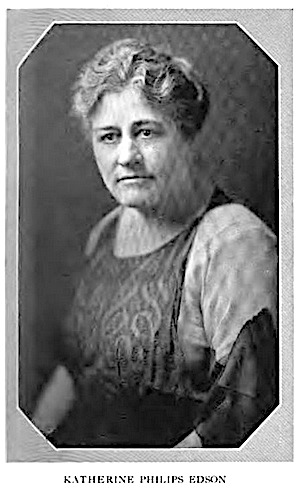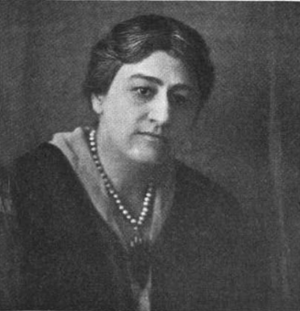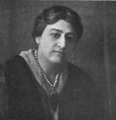Katherine Philips Edson facts for kids
Katherine Philips Edson (born January 12, 1870 – died November 5, 1933) was an American social activist. She played a very important role in improving working conditions for people in California and across the United States.
Contents
Katherine Edson's Early Life and Activism
Katherine Philips was born in Ohio in 1870. Her father was a doctor during the Civil War and strongly supported women's rights. Katherine went to public schools in Kenton, Ohio. She also studied at a school called Covent of Sacred Heart. Later, she moved to Chicago to study music at the Chicago Conservatory.
In 1890, she married Charles Edson. They moved to Antelope Valley, California, where Katherine became a leader in the Women's Suffrage Movements. This was a movement to get women the right to vote.
In 1900, Katherine and Charles moved to Los Angeles. There, Katherine joined the Friday Morning Club. This was a large women's club started by Caroline M. Severance. The club worked for public changes and organized health campaigns. Katherine quickly became the club's secretary. She helped make changes to local government and was very important in getting women the right to vote in California in 1911.
Katherine believed that women had important interests outside their homes. She felt they should fight against unfair conditions and be treated as full citizens. Her work helped create new laws for better working conditions and more rights for women. Even after she passed away, her efforts continued to inspire others to fight for fairness.
Fighting for Fair Working Conditions
Katherine Edson felt she was meant to be involved in politics. Her family, especially her father, encouraged her to join social activist groups from a young age. She believed her father was why she started fighting for women workers' rights. Edson wanted to make the country fair for everyone.
Joining the National Municipal League
In 1912, Katherine was chosen to be part of the Council of the National Municipal League. She worked with Meyer Lissner, who became her political guide. Lissner appointed her to the Bureau of Labor Statistics in 1912. Even though she was supposed to focus on public education, Katherine spent more time on women's health and working conditions.
She helped create the first set of laws the Federation wanted to pass. In 1913, she joined the Women's Legislative Council of California. Katherine and other women pushed lawmakers and clubs to support ideas like a minimum wage for women. A minimum wage is the lowest amount of money an employer can legally pay a worker.
Pushing for Minimum Wage
In 1913, Katherine asked women's clubs across California to study the wages, hours, and working conditions in their communities. This survey aimed to show other women's groups how bad working conditions were and why new laws were needed.
While these groups investigated, Katherine worked hard to pass Assembly Bill 1251, a minimum wage bill. She argued that women, as "potential mothers," needed to be paid enough to live on. Many groups supported this bill, including women's clubs and churches. However, labor unions did not support it. They worried that better conditions for women might make unions seem less necessary.
Despite the opposition, Governor Johnson pushed the bill forward. It passed with a vote of forty-six to twelve. Katherine Edson's strong activism was key to this success.
The Industrial Welfare Commission (IWC)
After 1910, a group of politicians called "progressive Republicans" gained power in California. Hiram Johnson, a leading progressive, wanted to give control back to the voters and create laws that helped society. To do this, they set up special groups called commissions.
In 1913, the state created the first Industrial Welfare Commission (IWC). Its job was to investigate the working conditions and wages for women and children. Katherine Philips Edson was a very important supporter of this new commission. She was the first woman appointed to the IWC's executive committee, serving for almost eighteen years (1916–1931).
Many of the IWC's early successes were thanks to Katherine's efforts. She wrote bills and convinced lawmakers to support them, gaining help from many women's groups. Under her leadership, many employers and employees reached agreements during meetings she led.
With the IWC, women in California received the highest minimum wage in the United States. Working conditions improved greatly, and the eight-hour workday was enforced. The IWC brought order to the job market where it was needed.
However, the IWC also faced challenges. For example, in 1921–1922, the minimum wage had to be changed several times. The IWC also struggled to make sure all businesses followed the rules, especially canneries in Southern California.
Cost of Living Studies
In late 1915, Edson published a study called "The Cost of Living." The IWC interviewed about one thousand working women. They asked these women to compare their weekly pay to the prices of clothes, food, and other things they needed. From these reports, Edson calculated that the cost of living was about $9.63 per week. The Bureau of Labor Statistics showed that half of the working women earned less than nine dollars a week. This proved that many women were not earning enough to live on.
After World War I, the cost of living kept going up. In 1920, another study led to a new minimum wage of sixteen dollars. But by 1921, businesses slowed down, and employers complained that sixteen dollars was too high. They asked for the minimum wage to be reevaluated.
Katherine Edson resisted pressure from business owners to lower the minimum wage. However, she agreed to a compromise. She recalculated the costs of living, and her new number was fifteen dollars. The IWC accepted this new minimum wage, but some labor groups were unhappy.
Leaders of the California State Federation of Labor criticized Edson for setting a fifteen-dollar minimum for women workers when she earned much more. They even filed a lawsuit against her. However, in September 1922, businessmen agreed to the sixteen-dollar wage again. By December, the commission officially brought back the sixteen-dollar minimum wage. This turned out to be better for employers in the long run than a lower wage.
Katherine Edson's Final Years
Katherine Edson faced many health problems in her later years. In 1923, her husband left her. She also had several serious illnesses. Despite her declining health, she remained politically active.
In 1930, a new head was appointed to the Division of Industrial Welfare, which led to Edson's job ending. The new head, Mrs. Mabbel E. Kinney, lowered the wage standards that Edson had worked so hard to keep. This caused the IWC to become less active.
Even though she was very ill, Katherine continued to advise Kinney and lobby for the League of Women Voters. She pushed for a larger budget for the IWC. In 1933, she was asked to help write a new national code for the canning industry, but she was too sick to accept. Katherine Philips Edson passed away on November 5, 1933. Her dedication to improving the lives of working women left a lasting impact.
Images for kids





